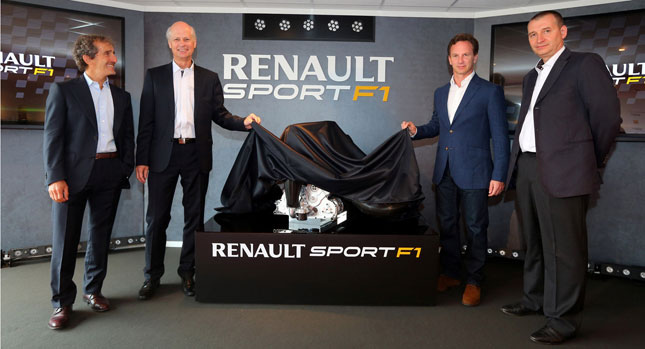Starting with the 2014 season, Formula 1 regulations shift drastically, and the most significant change is the switch from 2.4-liter normally aspirated V8 engines to 1.6-liter direct-injected turbocharged V6 units.
Renault is the first F1 engine manufacturer to present the new power unit, officially named Energy F1-2014 to reflect synergies with the fuel-efficient Energy engine used in its road cars. The 1.6-liter V6 engine is fitted with energy recovery systems that increase efficiency by harvesting energy dissipated as heat in the exhaust or brakes.
The new power unit develops a total of around 760 horsepower, 600 hp of which will be supplied by the 1.6-liter engine. The remaining 160 horsepower come from the energy recovery system. Renault says the maximum power of the new Power Unit will exceed the output of the current V8 F1 engines, despite the fact that fuel efficiency will be improved. New regulations allow only 100 kg of fuel for an entire race, meaning the new units will have to use 35 percent less fuel than their predecessors.
Compared to the current V8, the new V6 will have a lower rev limit of 15,000 rpm, down from 18,000 rpm. However, the turbocharger with a maximum boost pressure of 3.5 bar and the new ERS (Energy Recovery System), which is twice as powerful as the current KERS (120kW vs 60kW), will more than compensate for that. The new engine will also have to be more reliable, as each driver will only be allowed to use five engines for the entire season, down from eight units now.
So with all these changes, what will happen to the beautiful sounds of V8 engines? Renault says engine noise will remain an important ingredient of the F1 show. “Fundamentally the engine noise will still be loud. It will wake you from sleep, and circuit neighbors will still complain. The engine noise is just a turbocharged noise, rather than a normally aspirated noise: you can just hear the turbo when the driver lifts off the throttle and the engine speed drops,” says Rob White, Deputy Managing Director (technical). Well, that’s reassuring enough – for me at least.
By Dan Mihalascu
PHOTO GALLERY


















